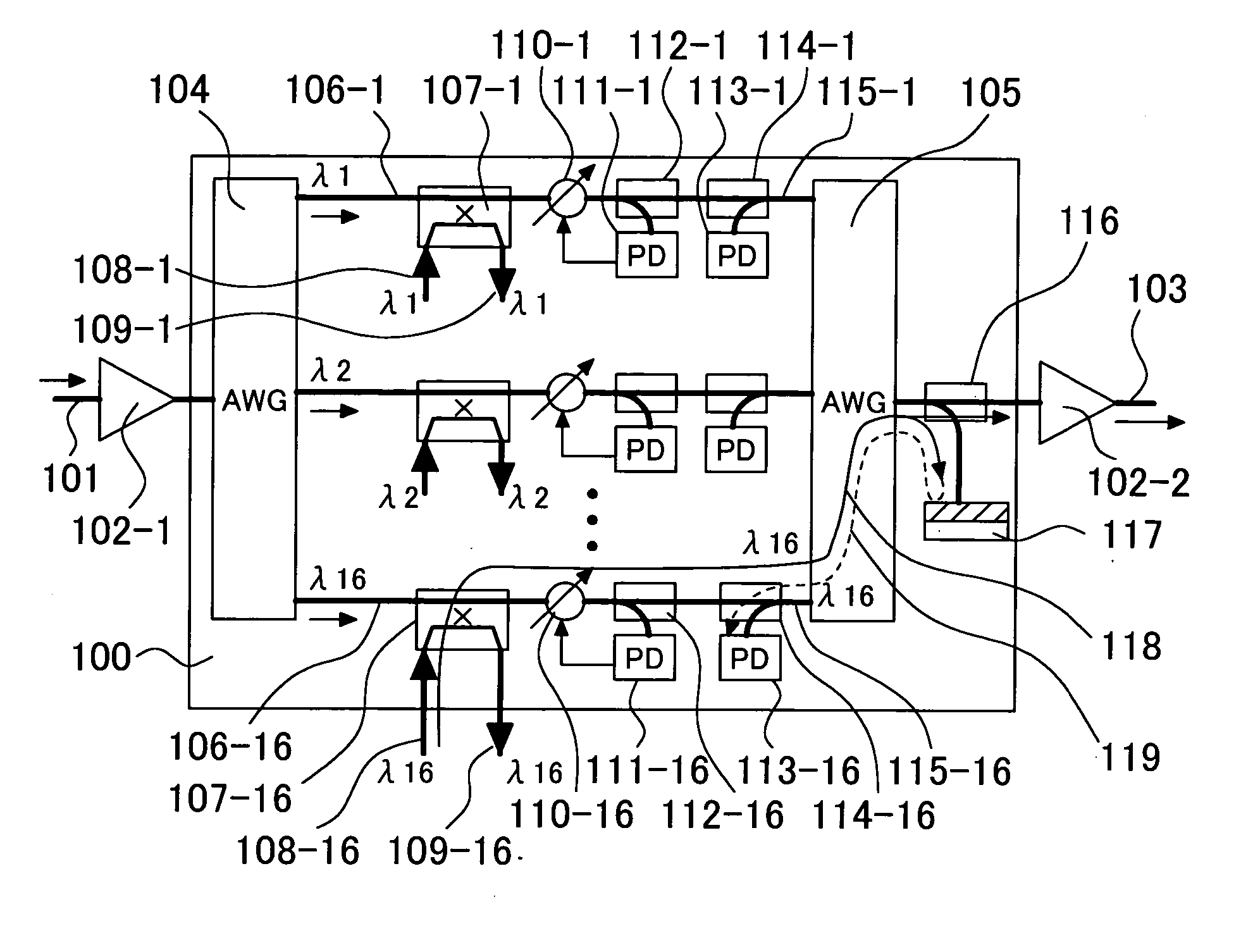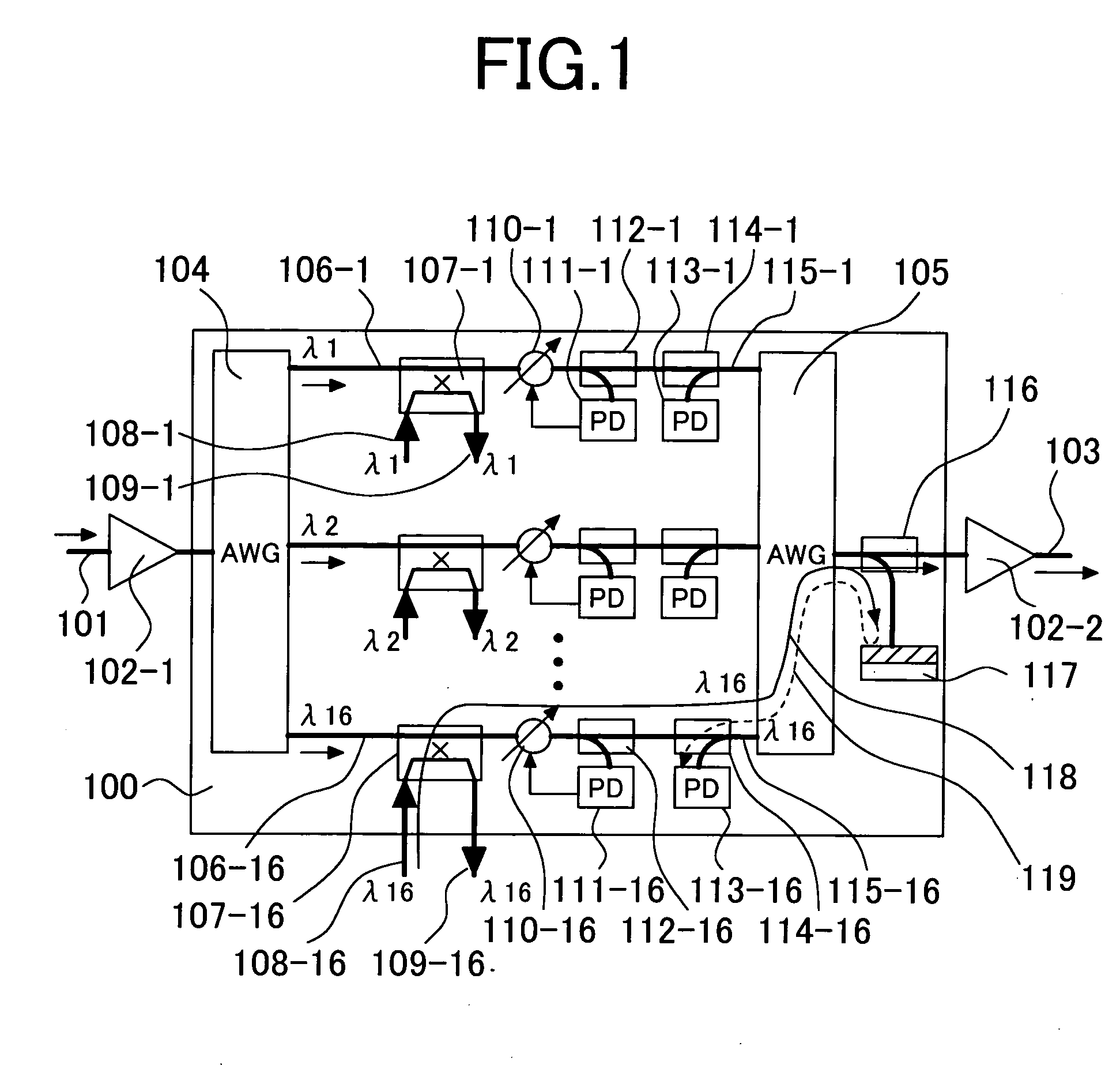Optical wavelength add-drop multiplexer
a technology of optical wavelength and multiplexer, which is applied in the field of optical information transmission, can solve the problems of large problem, insufficient mechanism provided for optical wavelength add-drop multiplexers, and inability to detect wavelength errors, so as to prevent a count error of the number of wavelengths, prevent a wavelength error, and detect wavelength errors quickly
- Summary
- Abstract
- Description
- Claims
- Application Information
AI Technical Summary
Benefits of technology
Problems solved by technology
Method used
Image
Examples
first embodiment
[0052]FIG. 1 is a configuration diagram illustrating a first embodiment of the present invention. FIG. 1 illustrates a configuration example of a reconfigurable optical wavelength add-drop multiplexer (ROADM) 100 to which the present invention is applied. This configuration is made by adding optical couplers 114-1 through 114-16, backward direction optical detectors 113-1 through 113-16, an optical coupler 116, and a mirror 117 to the conventional configuration shown in FIG. 2. The optical coupler 116 branches part of a wavelength division multiplexed optical signal output from the reconfigurable optical wavelength add-drop multiplexer 100, and then introduces the branched optical signal (for example, about from 1 to 20%) into the mirror 117. As a result, the part of the wavelength division multiplexed light is reflected and then passes through the optical coupler 116 again, and consequently enters a optical wavelength multiplexer 105 in the reverse direction. The wavelength divisio...
second embodiment
[0064]FIG. 8 is a configuration diagram illustrating a second embodiment of the present invention. This is an example in which part of a wavelength division multiplexed signal output to an output optical fiber 103 is branched by the optical coupler 116, and the branched wavelength division multiplexed signal is then inputted into the wavelength meter 160 where wavelengths of optical add signals are measured. For example, if the 2×2 optical switch 107-16 for switching an optical signal having the wavelength λ16 between the through state and the add state is in the add state, when an incorrect optical signal having the wavelength λ3 is inputted into the optical add signal input fiber 108-16, the optical signal is blocked by the optical wavelength multiplexer 105 as shown by the path 122. Accordingly, although the optical signal is detected by the forward direction optical detector 111-16, this optical signal does not arrive at the wavelength meter 160. On the other hand, when a correc...
third embodiment
[0066]FIG. 9 is a configuration diagram illustrating a third embodiment of the present invention. This is an example in which the plurality of input optical fibers 115-1 through 115-16 of the optical wavelength multiplexer are further provided, respectively, with optical couplers 163-1 through 163-16, optical bandpass filters 161-1 through 161-16 that passes only optical signals having the wavelengths 1 through 16 respectively to block the other wavelengths, and optical detectors 162-1 through 162-16 so that the judgment can be made as to whether or not an optical add signal having a correct wavelength has been detected. For example, as indicated by the path 118, part of an optical add signal having the wavelength λ16 inputted into the optical add signal input fiber 108-16 is branched by the optical coupler 163-16. After that, the branched part of the optical add signal passes through the optical bandpass filter 161-16 that passes only an optical signal having the wavelength λ16, an...
PUM
 Login to View More
Login to View More Abstract
Description
Claims
Application Information
 Login to View More
Login to View More - R&D
- Intellectual Property
- Life Sciences
- Materials
- Tech Scout
- Unparalleled Data Quality
- Higher Quality Content
- 60% Fewer Hallucinations
Browse by: Latest US Patents, China's latest patents, Technical Efficacy Thesaurus, Application Domain, Technology Topic, Popular Technical Reports.
© 2025 PatSnap. All rights reserved.Legal|Privacy policy|Modern Slavery Act Transparency Statement|Sitemap|About US| Contact US: help@patsnap.com



